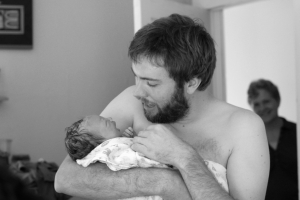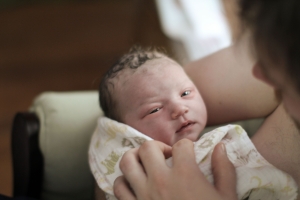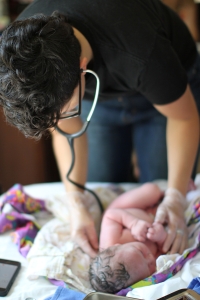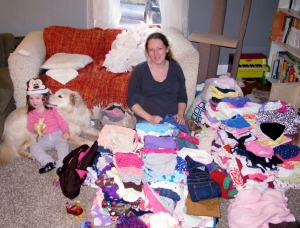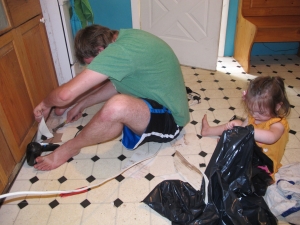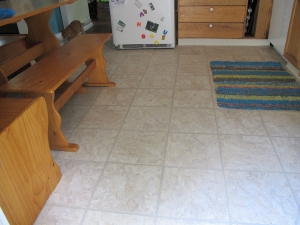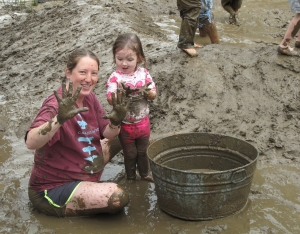Hayl’s Quilting Class: Prelude – Shweshwe Fabric
In the past few months, I’ve done very little other than work, work, work, with a side of housework. While setting up our new house is fun, it’s also been stressful, since my few precious days off are torn between resting/recovering from the week, catching up on grading and lesson planning, obtaining essential furniture and appliances to make our new home functional, and chores/housework/yardwork. (I’m exhausted just typing that!)
All that is to say, I am in desperate need of something fun, creative, and social as a relief from all this work. So I signed up for a quilting class at a local fabric store!
My first class is this afternoon, and later I’ll post about piecing the quilt squares we’ll learn today. But first, I wanted to take a moment to talk about the fabric I’ll be using in my quilt. While in South Africa, I purchased some traditional shweshwe fabric:
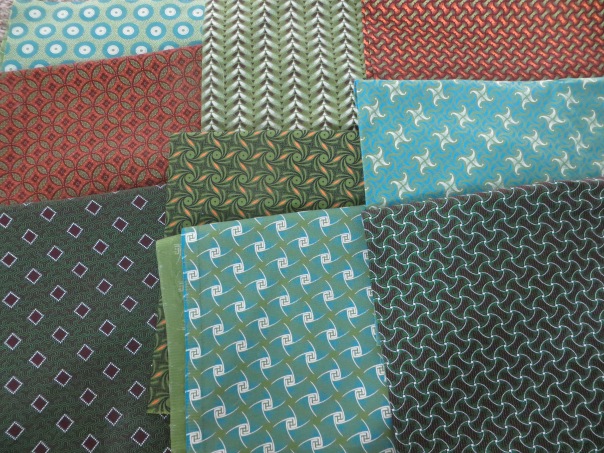
Shweshwe, like most things South African, has a long and complicated history involving the intersection of native cultures (in this case, primarily Xhosa and Sotho cultures) and European colonialism. (A good write-up of the history of the fabric can be found here.)
I purchased shweshwe in new, modern colors – but in the traditional geometric patterns. Before the 1990s, the fabric was only available in blue, as it was originally dyed with indigo, even though a synthetic indigo dye had been used for a century. In the ’80s and ’90s, production of the fabric shifted from Europe (where it had originated in the 18th and 19th centuries) to South Africa. New colors of chocolate brown and bright red were introduced, and new colors like these greens, teals, and oranges have only become available in recent years.
With the end of apartheid in the 1990s came the forging of a new national culture in South Africa, and it seems shweshwe has had a significant role in that. Though its origins are European, today shweshwe is uniquely South African. Da Gama Textiles in Zwelitsha in the Eastern Cape is now the only place in the world where this type of traditionally printed fabric is produced. In South Africa, the fabric is ubiquitous: it is used for dresses, aprons, headwraps, purses, tablecloths, etc. In addition to the traditional geometric designs, a particularly popular fabric is the Nelson Mandela print:
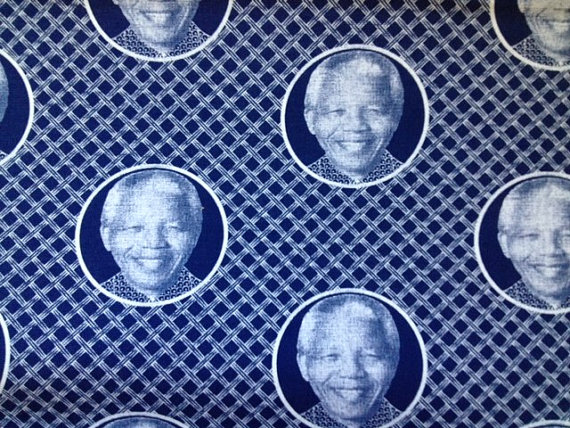
In my quilting class, we will be making a quilt from the book Sister Sampler Quilts by AnneMarie Chany.
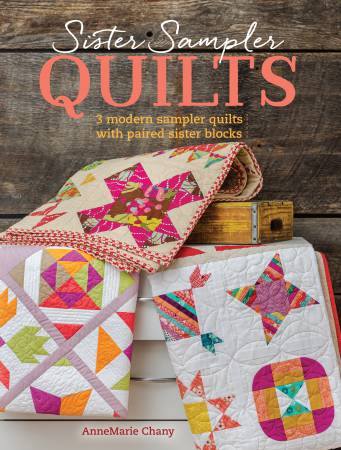
The quilt is described as a “traditional quilt blocks set in a modern quilt.” This description struck me as being perfect for my shweshwe fabric. The art of quilting has always been about connecting history and heritage with the present and the future. Chany says of the quilt I’ll be making: “This quilt’s theme centers around your favorite women.” The blocks all have names like Grandmother’s Frame, Aunt Eliza’s Star, Sister’s Choice, or (my personal favorite) Contrary Wife. Of course, I am inspired to quilt by my mom – and I’ll be using the sewing machine my Granny gave me. Visiting the fabric store with Nora, my mother-in-law, motivated me to sign up for the class in the first place. So of course this quilt will celebrate my favorite women, in addition to celebrating my favorite places in the world through the fabric I’ve chosen. At the same time, I’m making it during a very new stage of my life – our first year in a new state, living in our first house, and in my second year of teaching high school. Both the fabric and the quilt layout are a mix of traditional and new, and that’s right where I need to be right now: holding on to what came before while looking forward.
Why I march… science edition.
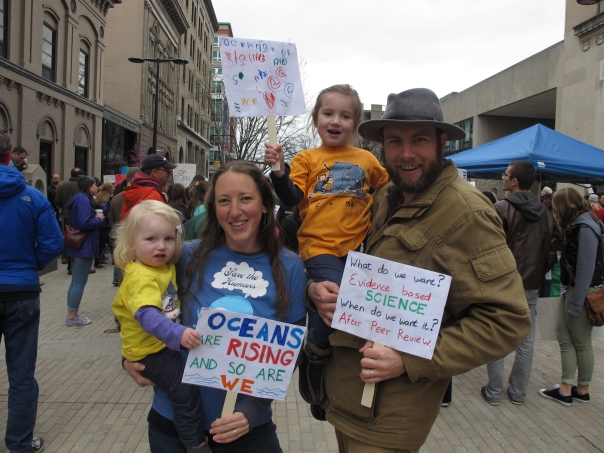
And we’re back out on the streets. For some reason, science is no longer a priority for the government. Under the current regime of minimizing domestic programs, the White House has proposed huge cuts to the NSF, EPA, NIH, NASA, the Office of Science at the DOE, shall I go on? And what is even more baffling, modern policy development often contradicts well-established scientific research.
I can’t compete with the numerous well-researched and exposited outcries from the scientific community and science enthusiasts about the risks of the anti-science shift in the present administration. However, to add to the content on this issue, I present the letter I wrote to my congressional representative about the connection between my own research and real-world problems. My work can serve as a single example of the 6 million scientists who are running labs, building models and solving problems to make the world a better place. (For a quick summary, skip to the bold paragraph near the end.)
Representative Tom Reed
401 E. State St. Suite 410
Ithaca, NY 14850
Dear Representative Reed:
I am a postdoctoral associate in a joint collaboration with the Cornell Atkinson Center for a Sustainable Future and the Environmental Defense Fund. I am writing to ask you to reject President Trump’s massive cuts to science in his FY18 proposed Federal Budget. While efforts to construct a thoughtful and balanced federal budget are admirable, Congress will do well to remember that the value of scientific research far outweighs the cost.
My current research is focused on transforming fisheries science and management through the development of a robotic Mobile Ocean Observing Network along the Pacific coast of the US and Canada. Incorporating acoustic surveys from unmanned vehicles will dramatically improve the spatial and temporal resolution of fisheries acoustics data collection, serving to improve stock assessment precision for coastal pelagic species such as sardine and anchovy. A synoptic view of the distribution and abundance of these species will allow a refinement of harvest control rules and improve fishery management under dynamic oceanographic conditions.
Funded by the Department of Defense through the NDSEG fellowship, I completed my dissertation in the Ocean Resources and Ecosystems program in Cornell’s Department of Earth and Atmospheric Sciences. During my graduate work, I used demographic models to show the effects of climate-induced fluctuations in the Gulf of Maine plankton community structure on the endangered North Atlantic right whale. This research delves into Arctic and North Atlantic teleconnections that drive regional changes in the Gulf of Maine ecosystem, as characterized by the climate and oceanographic indices such as the North Atlantic Oscillation, Arctic Oscillation and the North Atlantic coupled slope water system. Without an understanding of these global-scale climate processes, it would have been impossible to accurately characterize the demographic dynamics observed in the North Atlantic right whale population. The right whale is at severe risk for extinction with only 522 animals remaining, and careful research into the mechanisms that effect population growth and demography is essential for the successful management of the species.
This summer I will begin a postdoctoral position at the Marine Science Institute of UC Santa Barbara. This research, funded by the federal Bureau of Ocean Energy Management, will examine the feasibility of repurposing decommissioned oil rig infrastructure to provide artificial reef and nursery habitat for vulnerable rock fish in the Santa Barbara Channel.
In each of the research projects that I have undertaken as a marine ecologist, there are clear benefits that outweigh the federal costs of funding my research. Science research acts to improve efficiency, minimize risk and provide new technology. Using my own work as an example, after several years, the cost of developing a robotic ocean observation network will reduce ship-based survey costs while increasing the economic value of fisheries by enriching data streams. If my next research project shows that rigs provide suitable habitat for vulnerable marine fish and invertebrates, oil companies and the state of California will considerably reduce spending on massive infrastructure removal, and this program can serve as a model for future ocean infrastructure projects. In all three projects described, my work aims to minimize the risk of biodiversity loss and further ecosystem degradation.
For these reasons, I urge you to reject President Trump’s proposed science funding numbers and continue to support the National Science Foundation (NSF). NSF funding has supported some of the research described in this letter, and provides 68% of extramural federal support for non-medical biological research. Please support an NSF funding level of $8 billion for fiscal year 2018. This would allow NSF to maintain a number of programs that are critical for science innovation and education in the United States. Funding scientific research supports the New York State and the 23rd District’s economies, and is vital to U.S. competitiveness.
Sincerely,
Dr. Erin Meyer-Gutbrod
Postdoctoral Associate
Cornell University
Why I March
It has been made clear to me that many Americans looked at the millions of people taking to the streets in the Women’s March demonstrations yesterday and don’t understand why. My family members and some friends have seen that I joined this march, and they don’t understand my motivations. After all, women enjoy many political and social benefits that seemed unattainable 100 years ago. As always, I am more than happy to clarify my position, and my connection with several political issues that have garnered national attention. This is why I march:
I march because I have a PhD in climate science. Money from oil companies and other interest groups that benefit from the exploitation of fossil fuels continues to fund our campaign system. In return, politicians deny well-researched climate science. Climate FACTS should not be up for political debate. We cannot afford to wait 4 years before committing to a carbon neutral America. The time for action is NOW.
I march because I worked full-time for the same employer for 6 years and gave birth to 2 children. I received 0 days of paid maternity leave.
I march because the cost of enrolling ONE child full time in my employer-sponsored daycare facility costs as much as my take-home pay.
I march because, in the US, 1 in 5 women are sexually assaulted in their lifetime. I have 2 daughters. I do not like those odds.
I march because I grew up in a home with severe domestic violence. The police that responded to my frequent calls favored the assailant as a response to community politics involving my family and misogyny, which is a common and age-old practice. I have learned to treat police with caution and expect bias. The police provide a wonderful service that I am grateful to have access to, but every institution must be held accountable for their operations.
I march because I have attended wedding ceremonies of same-sex couples, and I felt humankind strengthen and revitalize as it does with any celebration of love. Love is good, and must be protected.
I march because I was ridiculed in high school for being the only female to take an Advanced Placement computer programming class. Well, look at me now.
I march because I have worked alongside illegal Mexican immigrants. They worked as hard as their peers while receiving less pay and zero governmental protections. Rather than take advantage of their vulnerability by ripping them from their life and family here, let’s offer them the same protections that the rest of us take for granted. We are a nation of immigrants.
I have had personal experience with many of the issues that are currently under political debate. And despite my childhood exposure to financial hardship and violence, I recognize that I have lived a life of privilege. I am sympathetic to others who have faced struggles different from mine. I march for them, too.
Am I grateful for the rights and protections offered by my country? Yes I am. Am I proud to be an American? Hell yes. Can we do better? Yes we can.

Fostering Imagination
As a parent, it is my job to teach my children about the world. As a scientist, I believe it is critical to be honest, encouraging education that is straightforward and fact based. I prefer to give full disclosure on tricky subjects such as where babies come from, what hamburger is made of, and what happens when you die. Even when it comes to discipline, I don’t like to cut corners for the sake of avoiding a meltdown. For example, when my toddler is desperate to play for 10 more minutes with the toy train, I won’t fib that the library is about to close. Instead, I tell the truth – it’s late and mama needs to start cooking dinner. Or why tell her that the cookies are all gone when really she isn’t allowed to have another one? That’s delaying inevitable (and important) lessons.
And yet, I believe there is tremendous value in make-believe. I do what I can to show my children that the world is indeed a magical place. Maria Montessori cautioned adults from undervaluing the tinkering and nonsense that young children invest themselves in, explaining that “play is the work of childhood.” Here are a few ways that I try to foster imagination in my 3 year old daughter:
Hiking through the gorges in Ithaca, we cross over many beautiful, old stone bridges each week. I like to remind Evee that trolls live under some bridges, and may demand tolls from people who want to cross. Sometimes my husband or I will pretend to be the troll, and demand a bauble or gesture from Evee such as a flower, pebble or kiss on the cheek. This always gets her giggling, and often ends in requests for the troll to chase her.

Craning to see the troll under the bridge
Evee and I also love to speculate about the magical places where fairies live. When I come across something like a small stone bench, birdbath, or outdoor nook walled in by ivy or a trellis, I tell Evee about how garden fairies are attracted to places like this. We discuss what we can do to cultivate garden fairies in our own yard. Water fairies are hiding in the lush, dripping moss growing around the waterfalls where we hike , and we always squint into the sun trying to catch a glimpse.
Our bedtime chapter book right now is The BFG by Roald Dahl. Last night we read the chapter where the BFG takes Sophie to dream country to catch dreams in his net to bring to children. This morning, Evee listened for the invisible dreams zooming around our backyard. She caught them in her net, and we bottled and labeled the dreams that she caught. For the next few nights, we’ll make a show of releasing one of the good dreams from the jar before she goes to bed. But under no circumstances will we ever release the Trogglehumper, which is a terrifying nightmare.
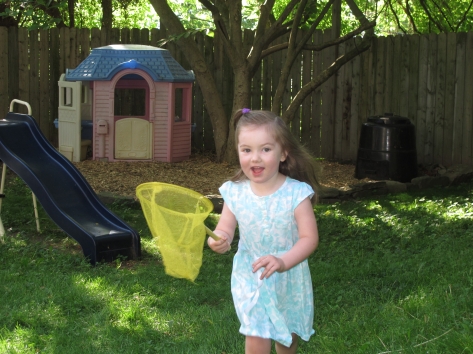
Chasing dreams in the backyard

We caught a Winksquiffler, Phizzwizard and even a nefarious Trogglehumper
There’s so much magic in our world that we have yet to discover, and I don’t want my children to close their minds off from any of it. While spending time bartering with trolls may not seem as practical as practicing ABCs or even getting comfortable on her new bike, these exercises in imagination give her the insight and the courage to explore beyond the scope of contemporary knowledge or known science to stumble upon new ideas and hidden wonders. I hope my girls will never outgrow silly, imaginative and magical things like chasing dreams and cultivating fairies.
The joys of mothering
At the end of May, the month of Mother’s Day, here are a few things that made me happy to be a mom this year:
Every single action in my day is observed, questioned and interrupted. I am constantly answering to my little ones, assisting with everything. How is it that such small people can be so hugely demanding? Yet, like everything in life, the more you put into it, the more rewarding it is. And parenting is really the ultimate example of this. This post on the Austin Mom’s Blog perfectly captures the absorbing and exhausting nature of parenting young children, and I couldn’t agree more with the last paragraphs:
http://austin.citymomsblog.com/2016/04/20/stage-life-hard/
And thinking about the rich rewards of motherhood, this video gave me all the feels:
Finally, motherhood would be a much sadder, lonelier and colorless experience without a fabulous, remarkable, engaged and loving partner to share it with. There is no one I would rather tag team these little beasties with than my best friend:
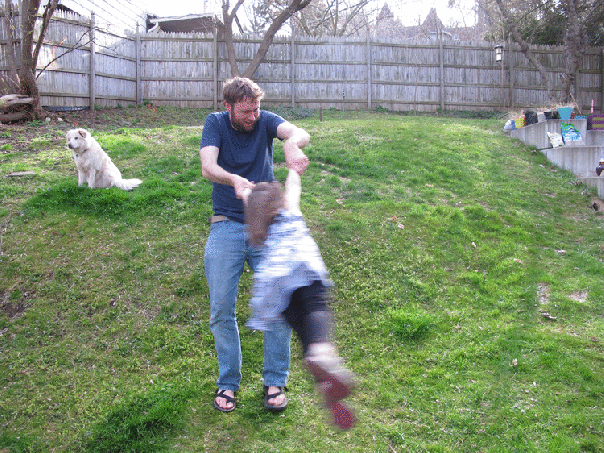
Babies don’t keep
Mother, oh Mother, come shake out your cloth
empty the dustpan, poison the moth,
hang out the washing and butter the bread,
sew on a button and make up a bed.
Where is the mother whose house is so shocking?
She’s up in the nursery, blissfully rocking.
Oh, I’ve grown shiftless as Little Boy Blue
(lullaby, rockaby, lullaby loo).
Dishes are waiting and bills are past due
(pat-a-cake, darling, and peek, peekaboo).
The shopping’s not done and there’s nothing for stew
and out in the yard there’s a hullabaloo
but I’m playing Kanga and this is my Roo.
Look! Aren’t her eyes the most wonderful hue?
(lullaby, rockaby, lullaby loo).
The cleaning and scrubbing will wait till tomorrow,
for children grow up, as I’ve learned to my sorrow.
So quiet down, cobwebs. Dust go to sleep.
I’m rocking my baby and babies don’t keep.
-Ruth Hamilton
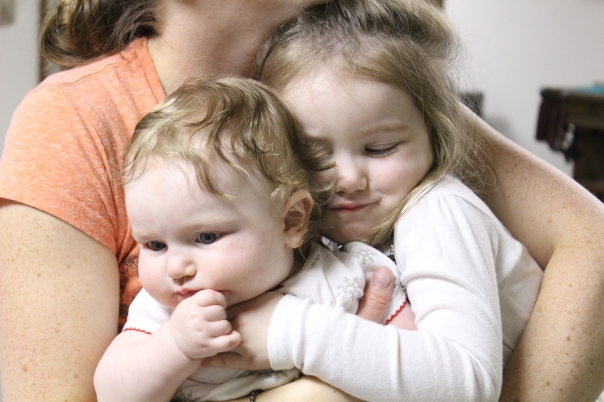
I know I’m behind on blogging. I’ll get back to it, I promise.
The story of Hazel’s birth
On July 30, 2015, probably the hottest day of the year and 3 days past my due date, I was 60lb over my pre-pregnancy weight and desperate for my second baby to be born. Planning a homebirth with Sandra Londino, I asked my midwife to come to my house in the afternoon and strip my membranes, a simple procedure to get your body to produce prostaglandins and encourage labor. This worked to induce labor for my first pregnancy so I was very hopeful that it would work again. I went to bed around 10pm that night and woke up just after 1am starving. Josh helped me downstairs and made me a baked potato, then went back up to bed. I ate, watched some TV and enjoyed some quiet time, but was too restless to go back to bed. By 3am, I started having recognizable contractions, that were a bit uncomfortable but certainly not painful. I woke my husband again to tell him that it was go time!
Josh bustled around the house rounding up the truckload of supplies that we had gathered in anticipation of a homebirth. Then he started to inflate the kiddy pool we bought to serve as a labor tub. I walked around the house very slowly and deliberately, pausing to lean over any high surface (cat tree, countertop, dresser or windowsill) depending on what room I was in. Contractions immediately started coming every 3-4 minutes, just as they did when I was in labor with my firstborn, Evee. The contractions were powerful and required all of my concentration, but I still really didn’t find them very painful. I gave my midwife a quick call just so she knew what was going on, but I asked her to stay at home, knowing that she lived just 2 blocks away and could get here in a flash. With 2-year-old Evee and Janet (Josh’s mom) sleeping, the house was so peaceful that I felt like a confident, competent little elf, working secretly and silently in the middle of the night to make something wonderful.
The intensity of my contractions ramped up steadily, and just before 5am I felt like they had turned a corner. They were incredibly powerful, and that power started to feel like pain, although it was definitely bearable. I asked Josh to call the midwife and tell her to come over. I slipped into the tub set up in my living room, and filled with 100*F water. Ahhhh. The tightness and tension that had been creeping up on me melted away and I felt peaceful again. A few minutes later, Sandra quietly entered my house and Janet woke up and creeped down the stairs to find me laboring in the tub. Although the almost magic quality of the night was interrupted by the arrival of people, everyone whispered and moved slowly, so the calm, secretive peace was preserved.
I asked Sandra to do a quick cervical check to get a baseline for where I was in labor, so she leaned over the tub and slipped her fingers inside me. “Do you feel like pushing at all?” she asked. Definitely not. “Well you’re about 9cm dilated”. Holy cow! I’d made it through almost all of the labor in just over 2 hours, and with surprisingly little pain! By the time I was at this stage with Evee, it had been almost 11 hours, 9 of which were spent gradually (and sometimes not gradually) changing my personal definition of “unbearable pain”.
So I waited quietly in the tub, where my contractions were painful but manageable and my muscles felt deliciously loose in the hot water. I waited for a sign from my body that it was time to meet my precious baby. At the end of my labor with Evee, I felt an incredibly powerful, impossible to ignore desire to push, and the result was an 8lb 5oz little girl after only 20 minutes of pushing. So with Hazel, I knew just what to look for. By 7am, 2 hours of laboring in the tub and wondering when I was going to get that feeling, I was pretty burnt out. The contractions were coming fast and incredibly painful, I was exhausted, and another exam proved that I hadn’t made any progress. What was going on? Why wasn’t Hazel coming?
I decided to get out of the tub, despite my exhaustion, and try to shake her into action. I explored my living room, restlessly looking for a place to stand, or kneel, or move in a way that would get this baby to move down into my birth canal. I spoke with Sandra about breaking my amniotic sac, but she preferred not to disturb the natural process and wanted to wait it out. But I had been in the transition phase for 2 hours, battling ever increasing levels of pain, and there was no change in the baby’s station (how far down she was into the birth canal) or my dilation. I decided to try to take matters into my own hands and see if I could push her down, even though I didn’t feel the urge. I slowly and deliberately climbed my stairs with Josh’s attentive assistance, and decided to sit in the bathroom to try to use the familiar space to try and stimulate a pushing urge.
After 20 minutes of wearing myself out pushing against nothing and making no progress, I felt like I could here my mother’s voice in my head: “The Dr. had to break my sac for both you and Pat; I think we may just have strong sacs.” Broken sac or no, I didn’t feel like I could wait patiently for this baby to descend any longer. I asked Sandra to break my sac, and she told me to lie down on my bed so she could perform the Artificial Rupture Of Membranes. Well, the act of lieing on my back in bed was so incredibly painful, I couldn’t bring myself to stay in that position for more than 1-2 seconds. Every time Sandra came near me with the little crochet-hook-device, I squirmed up in agony onto my knees and said “Just wait for this one to pass”. But it felt like a wall of contractions with no beginning and no end, and I felt terrible for the women compelled to lie on their backs during labor. It was unimaginable torture.
Eventually I managed to lie on my side and lift a leg up for 15-20 seconds so she could break the bag of waters. When it broke, only a little fluid came out, unlike the gush of water that drenched everything when the midwife broke my bag when I was around 7cm dilated with Evee. I imagine this is because I was farther in labor and Hazel’s head was blocking the canal, so most of the water was stuck behind her. However, when the sac ruptured, I felt immediate relief and the contractions slowed down dramatically and were much less painful. Also, right after the rupture, my urge to push finally showed up!! Sandra said I had immediately dilated to 10cm and it was time to have this baby.
I was already in my bed, which had been appropriately covered with protective sheets etc. to make for a clean, contained birth. But after only a moment of trying to push in bed, I felt like I couldn’t get the leverage or the position I needed to be in on the fluffy surface. I climbed out of bed, and poor Sandra, and the nurse Erianna Flores, who were trying to follow me around and predict where I would actually stop and have this baby, went back to moving the chucks pads and supply trays. I squatted on the floor, resting my arms and head on the foot of my bed, and finally felt like I could really push. The floor was so firm, and the bed provided a great spot to grip so I could curl around my huge belly and start pushing this baby down.
Evee had apparently woken about 30 minutes earlier and was happily playing with her grandmother in her room while all this happened. At this point, Janet came into my bedroom with Evee on her hip and I asked Evee if she wanted to stay and watch Hazel’s birth. She said she did and then I beared down to push again. This felt much different than pushing Evee out, Hazel felt like she was much bigger and more stubborn to move, and the feeling of trying to inch her down was incredible. Being in the squatting position and gripping with all of my strength on to the bed for leverage felt like the only way I could possibly make progress. But when I pushed, I sent the bed flying, so Josh asked Janet (still holding Evee on one hip) to stand on the far side of the bed and help hold it in place. Although Hazel’s descent felt incredibly obstructed, I could feel that she was moments (minutes?) away from being born and I felt very lucid. Sandra was positioned behind me, attentive to the birth, and I reminded her that Josh wanted to catch the baby.
Then I pushed with extreme intensity a few more times, making loud grunts and groans. Later I was told that Evee listened to these grunts, wide-eyed, and announced that “Mama is working hard!” I felt the “ring of fire” when it seemed like my birth canal was stretched impossibly wide as Hazel was crowning. This was so intense, that I had assumed I had just pushed Hazel’s head out of my body, and to my shock I heard Josh say that he could see some hair. Why was he just now announcing hair when that whole head had to be hanging out of my body? Although I was confused, I doubled down for some more intense pushing, and after what felt like, to me, the whole body had slipped out, Josh and Sandra announced that the head was out. Although it was painful to be squatting on the floor with a baby only half born, I took a break because I truly felt like my work was over. The urge to push had disappeared instantly and completely, and I couldn’t believe that Hazel wasn’t in my arms yet. But after a few moments, Sandra urged me to keep pushing; Hazel’s head was out but the rest of her body was stuck. In my head, I wondered “really? Shouldn’t she be born now?”, but I listened and tried to push anyways. Unlike the minutes before where pushing felt necessary and instinctive, I couldn’t feel anything, and I didn’t feel like I could get a grip on the baby to actually push. It felt like such a strange situation. As I tried to talk my body into working past quitting time, the atmosphere of the room changed. Because I was so internally focused, I didn’t realize it at first, but everyone was starting to get pretty nervous, and trying to instruct me.
Eventually I made eye contact with Janet, and she was talking to me, trying to help relay the instructions of my midwife. I heard Sandra ask me to stand up and lift my feet up. It was clear that she had already been asking me to do that, but in my haze I hadn’t heard her earlier instructions. I stood up, but my upper body was still curled around my belly because it felt crazy to stand up straight at that point. I think the midwife and nurse were frustrated because it was like trying to communicate to someone who was both blind and deaf, but eventually they made me realize that, although I didn’t want to, yes, indeed, I needed to stand up straight. Erianna got around to my front and started lifting one of my legs up, urging me to lift my knee up to my chest to help the baby come out. Finally I realized what was being asked of me, so I lifted first one knee to my chest, and then the other, in an exaggerated marching move. Once my second knee came up to my chest, Hazel slid right out of my body and into Josh’s arms. Thank God. Born at 7:52 am.
Although I was later told that the environment was noisy and anxious during the 3 minutes that Hazel’s head was out but her shoulders were caught behind my pubic bone (called shoulder dystocia), very little of the loud instruction and emotion had pierced the thick bubble surrounding me, and I would only learn later that we had just pulled through a very serious medical emergency. Josh, who had caught the baby while standing behind me, passed Hazel through my legs and into my waiting arms. I held her tight against my abdomen and carefully sat down on the floor, leaning against the side of the bed. I am told that she was pale and limp and not crying at this point, but I was in a state of shock and honestly didn’t notice. Sandra used a nasal aspirator to clear out Hazel’s nose and mouth while I clutched her to my body, and she immediately started crying, her skin pinked up and all of her muscles firmed. By one minute after birth, Hazel had an Apgar score of 9 out of 10. Everybody seemed to breathe a huge sigh of relief. I wanted to bring Hazel up to my chest, but like Evee, her umbilical cord was quite short and I had to keep her right on my lap. After a few minutes of catching our breath, Sandra noticed that the cord had stopped pulsing and offered to have Josh cut the cord so I could get Hazel into a more comfortable position. My first word after Hazel was born was a quiet but firm “No.” which actually surprised me as much as Sandra. Literally one second later, my body instinctively gave a little push and the placenta flopped out and right onto the floor. It was exactly 8am, meaning that the third stage of my labor was only 8 minutes long.
Josh cut the cord and I was carefully helped into bed to snuggle and nurse my beautiful, perfect little Hazel. About 15 minutes later, Ash and Tommy would show up after driving through the night. A short while after that, our friend Sarah would arrive to take photos of our brand new baby. Poor Janet would spend an eternity scrubbing a placenta-shaped blood stain out of the white rug on our bedroom floor. But for now, I just cuddled my gorgeous girl and thanked God that it was over. She was a 9lb, 1oz, 21 inch long bundle of joy.
Some facts about shoulder dystocia:
Effecting 1 in 200 births, when shoulder dystocia occurs in the hospitals, some obstetricians choose to immediately perform a “generous” episiotomy, cutting through layers of the mother’s tissue not to dislodge the baby, who is actually caught behind bone, but to allow space for the birth attendant to insert his/her hands inside the mother and attempt to twist the baby out. This can result in 4th degree tearing in the mother, potentially leading to a lifetime of incontinence, and 15% of babies will suffer nerve damage in the shoulder, and 10% of babies will suffer a broken collarbone. By “dancing the baby out” instead, I escaped without any tearing whatsoever and Hazel suffered only a bit of bruising from the pressure of her exit. Although I had a bruised tailbone, Hazel and I were spared a hellish recovery.
Homebirth critics will say, sure, a homebirth may be fine until anything goes wrong; but the truth is, homebirth midwives are trained to handle emergency situations, and although in some cases this may require transfer to a hospital, the overall statistics of home vs hospital births shows that mother and baby actually have a slightly better outcome at home deliveries following healthy pregnancies (reference: Janssen et al. 2009). And the story of Hazel’s birth is one of those cases that contributes to that statistic.
Turning Life into a Game: And Winning
I don’t know if it was turning 30, or hitting a new milestone on the scale, or simply that I have the time and energy to re-focus myself now that I’ve left grad school behind me, but recently, I’ve been making strides in improving my personal health and fitness.
Right now, I’m in the middle of an 8-week… game? diet? lifestyle challenge? Well, this thing, called the Whole Life Challenge. I got into it via peer pressure, mostly, as an increasing number of my friends in and from Connecticut have been doing Challenges over the past couple of years. I figured, if I wanted to improve my diet and exercise more, it would be easier to stick to something that my friends are doing, too.
But I’ve totally bought in to the principles of the Challenge. Halfway through, I am seeing small, slight changes to my daily habits that I think will stick with me (to some extent) after these 8 weeks are over.
Caveat: Part of why this has been a positive experience for me is that I’m naturally a competitive person. The whole gist of the WLC is that when you make healthy choices, you earn points; when you make unhealthier choices, you lose points. This means that you must care about the points for it to work. If you earn a certain amount of points, you can earn “indulgence tokens” (where you can eat something indulgent without losing any points), or even “free days” (where you get the full points for a day regardless of what you eat or do). So if you don’t care about points, this system will not motivate you at all. I’m the type of person who will try to get every single point possible (for an assignment grade, or a game, or whatever), even if the points don’t matter. So this works for me. (Sometimes too well, because I have to remind myself that it’s okay to not get ALL the points ALL the time!) But I know it doesn’t work for everyone.
There are 7 areas that you can earn points in, which is why it’s a “whole life” challenge and not a diet, though the category you can earn the most points in is Nutrition. This is the other reason why it’s not a diet: there aren’t things you “can” and “can’t” eat–instead, it’s all about making choices and forming habits. I didn’t really understand this distinction at first, but let me try to explain.
First, there are different levels you can play at. At the higher levels, you try to follow a whole-foods, Paleo-esque diet that cuts out processed foods, some grains, most dairy, and junk food. Now, I have mixed feelings about the Paleo diet–there are some good parts to it, but others I’m not so sure about. (Particularly, I think white potatoes and corn–which are restricted at the higher levels–are good for you.) But at the lowest level (“Kickstarter”), which I’m doing, you pretty much cut out most processed grains, cheese, most added sugars, and most junk food. All veggies are allowed, so any potential concerns I might have about the Paleo diet don’t really come into play. Oh, and all levels restrict alcohol to some degree–on Kickstarter, if I have more than 1 glass of wine in a day, I’ll lose points.
So there’ve been a lot of small changes that I’ve made to my diet. Oatmeal for breakfast instead of cereal with added sugar. Unsweetened soy milk instead of “Original.” Homemade lightly-sweetened iced tea instead of soda. Whole foods–and lots of veggies–for dinner instead of meals with calorie-dense pasta or cheese. Little things, but they add up over time. These are the changes that I expected, and part of why I decided to do the challenge in the first place.
But the most significant part of the nutrition component, that I did not expect, has nothing to do with these small shifts. Instead, it has to do with the way the points are structured. You don’t earn nutrition points, instead, you start off each day with 5 points, and any time you eat something that’s “non-compliant” (the above-mentioned restricted foods that I said you “cut out” of your diet), you lose a point. It’s actually better to think of it as spending the point. It’s like money. You can either spend a dollar now on a candy bar, or you can put it in the bank to earn interest (which you can then spend on a candy bar later, without using up any of your savings).
So above, when I referred to foods as being “cut out” or “restricted,” that’s not entirely true. I’m very bad at following diets. Several years ago, I tried out being vegan. I was terrible at it. A good friend of mine jokingly called me “the worst vegan ever,” because of how often I would cheat. If you tell me (or I tell myself) that I can’t eat something, well, I might eat it less, but I’m going to cave to temptation pretty darn often.
But if you tell me that something has a set cost, and it’s totally no problem at all if I’m tempted and then decide to go for it, then I’m going to think about whether or not it’s worth it–and I’m actually going to cave to temptation much less frequently. Take cookies, for example. When I was trying to be vegan, I was particularly terrible at resisting free cookies when offered. (Particularly the ones available before our late-afternoon departmental seminars.) On the challenge, though, I’ve been amazed at how many free cookies I’ve turned down. Where did this amazing strength of willpower come from?! Well, every time I’m offered a cookie, I think, “Is this worth spending a point on?” If it’s my favorite kind of cookie, lovingly homemade by someone I care about, the answer is going to be, “YES, it is totally worth a point to eat this cookie. Mmmmm.” But if it’s just a package of Oreos or something being offered to me, then instead of thinking, “Well, one won’t hurt,” and going for it, I weigh the options and think, “Nah, Oreos aren’t really good enough to be worth losing one of my precious few points on.” And then I say no! To free cookies!
I’ve thought some about the psychology that’s happening here. I’m not just forming healthy habits by making small changes to my diet. I’m forming healthier ways of thinking about my diet. Every time I’m presented with an unhealthy food option and I turn it down, I don’t say no simply because it’s something I’m “not allowed” to have, I say no because I’ve gone through this entire process of (1) asking myself is it worth it, (2) thinking it through, and (3) making a decision. This is classic reinforcement in psychology. Every time I make a decision to not eat something unhealthy, it helps lay down that pathway of thinking in my brain, and it’s much easier to decide not to eat something unhealthy the next time, because I’ve now formed a habit of making good choices.
This is one of the biggest effects the Challenge has had on me, and one that I’m pretty hopeful will stick with me beyond these 8 weeks. (By the way, I’ve already lost about 7 pounds since the beginning of the Challenge. Even though weight loss isn’t the whole point of the Challenge, that’s still averaging 1-2 pounds per week, which experts say is what you should aim for if you want to lose weight. Awesome!)
The other areas of the Challenge are Exercise, Mobilization (stretching), Supplementation (vitamins), Hydration, Lifestyle Practices, and Reflection. I’ll talk about those more in another post!
Nesting
Knee-deep in the third trimester, I’ve been going through a serious bout of nesting. It’s tough when you’re buried in piles of To Do lists but don’t have the energy to stand up from the couch. However, by capitalizing on short lived energy spurts and an incredible amount of help from my hard-working husband, we’ve been making it through the final weeks of pregnancy that always seem to coincide with lengthy and illogical lists of chores.
The first (and probably most fun) task in preparing for baby is sorting through your older children’s clothes. Having two girls spaced two years apart means that I probably won’t have to buy a single item of clothing for #2. However, I still needed to sort through and organize the mountains of clothes that Evee has outgrown. A more organized mom would have already stored old clothes by size and season, but where is the fun in that?
The most daunting task on my To Do list was to refloor the kitchen. Sure, this doesn’t seem like it has much to do with a newborn baby. However, since we ripped the (already stained, already torn) linoleum while moving the refrigerator in the first week of buying this house, I have been eager to refloor. We did a mountain of home renovation tasks when I was pregnant with Evee, so it’s no surprise that we didn’t make it to reflooring before she was born. Of course, after Evee was born, home renovation came to a screeching halt. Now that she’s older and much more independent, we have to capitalize on the short time we have left to get these big projects done before we re-enter the psychosis of caring for an infant. So with $500 in supplies and a full weekend of hard work, we managed to tear out the old, damaged linoleum and replace it with a really sturdy “floating floor”.
Our weekends are usually centered around fun, toddler-focused family activities, so Evee was pretty bummed out that we spent the whole weekend reflooring, but we made it up to her over the following weeks with lots of play dates, river swims and generally awesome outdoor fun.
We built three more planter boxes to line up with the three planter boxes we built a few years ago. Now with 6 boxes, we have created a sturdy fence at the top of our backyard retaining wall to stop young children from running down hill and falling 4 feet onto a concrete patio. It’s really just an eco-friendly toddler suicide prevention device.
We’ve also rehabilitated an old dresser to store baby’s clothes, painting it the same purple and green color combo that I used for the new planter boxes. I’ve replaced our frighteningly ugly love seat (featured in the picture above where I’m sorting Evee’s clothes) with a much less frightening love seat from craigslist. And of course the house has been deep cleaned.
Since I am planning a home birth, there’s some extra work that needed to be done to prepare for that. Apparently, a home birth generally requires an enormous amount of linens to mop up all the blood, gore, and amniotic fluid that will be flung about all willy nilly. So I asked for a linen donation from a local hotel, and they offered me a huge pile of sheets, towels and washcloths that no longer make the cut for room service. I bleached all of these, ran them through the hottest, longest drier cycle and stacked them into 10 paper grocery bags and stapled them shut. Each bag of linens was sterilized in my oven for an hour at 250*F, and piled in a giant box with other home birth supplies. We also bought an inflatable kiddy pool for me to labor in and a box of medical supplies that includes chucks, umbilical cord clamps, sterile scissors, latex gloves, plastic sheeting, etc.
Now I’m 37 weeks along (officially full-term!), and finally feeling like we are ready for this baby. Evee has been watching home birth videos every day and cannot WAIT to help take care of a newborn. She frequently reminds me that if she is sleeping when the baby comes, we need to wake her up so she doesn’t miss it. My mother in law is coming to stay with us for 3 weeks to ease the transition, the midwife is on stand-by and my body can’t possibly handle gaining more weight. So come on, baby!


